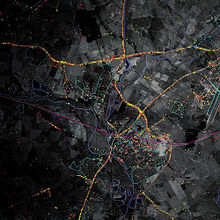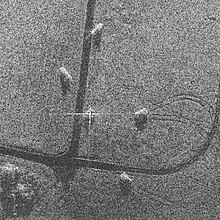Operating mode (radar)
The term operating mode defines special signal profiles for radar devices , each of which is optimized for specific tasks (e.g. searching for air targets or detecting ships at sea). The most important parameters in these profiles are transmission frequency , pulse power , pulse repetition frequency (PRF) and pulse length. Airborne radars in particular have a large number of operating modes, usually over 15, as they have to combat a large number of possible targets, while specialized devices such as search or fire control radarsget by with significantly fewer modes. Depending on the current situation and task, modern systems usually switch semi-automatically or fully automatically to the optimal operating mode, while older radars (such as that of the early MiG-29 ) require intensive operation by the pilot.
Operating modes
Some typical and frequently used operating modes are explained below.
Note: The designation of many operating modes often varies depending on the manufacturer, as the designations are not standardized. In addition, small changes to the usual modes are often given a new, but mostly similar name.
Air-to-air modes
Pulse search
Used for the exact determination of the target distance and the angle to the target, usually exactly one single impulse. The speed of the target can also be determined by means of several consecutive pulses, but this can be better determined by evaluating the Doppler effect , which is why mostly only older radar devices use this mode.
Track while scan (TWS)
In this mode, multiple targets can be safely tracked in one antenna pass while the radar searches for new targets at the same time. This process puts a lot of strain on signal processing , which is why many early radars were unable to provide this mode. The first TWS-capable radars were mostly able to track 5 to 10 targets at the same time, modern systems based on phased array antennas and powerful computer components can track about 20 to 30 contacts simultaneously.
Range while search
This mode only determines the distance to the target, but offers a very long range. Similar to the "Pulse search" mode, but the radar is continuously in search mode.
Velocity search
Another mode with a long range, works with a very high pulse repetition frequency. However, only determines the angle and speed of the target.
Raid assessment
The area around a recorded target is searched intensively with very short pulses in order to detect any hidden targets within a narrow formation .
Single target track (STT)
The radar continuously directs its entire energy and computing capacity towards a target, which means that very precise speed, angle and distance values can be determined. This is necessary, for example, when semi-active guided missiles such as the AIM-7 Sparrow are to be used, which require permanent target lighting. In close aerial combat ("dogfight") the pilot is supported with a target aid.
Slaved on external demand
In this mode, the radar is coupled to the pilot's helmet visor so that the pilot's line of sight aligns the radar antenna. This is particularly advantageous in close-up combat.
Dogfight
For close-range aerial combat, there are a number of modes with a variety of names. These modes usually provide aiming aid for the use of the on-board cannon and short-range guided weapons. Often, a narrow horizontal and / or vertical area is searched in order to quickly identify targets that are flying through and thus provide the pilot with better orientation.
Non cooperative target identification (NCTI)
This mode is used to identify targets that do not respond to an IFF query and are beyond the pilot's range of vision (" Beyond Visual Range "). Only modern radar devices are usually able to do this, as this method is based on the highly precise analysis of the radar echo, which places high demands on signal processing. The key feature of this analysis is the radar echo of the compressor blades , the number and speed of rotation providing information about the engine used and thus allowing conclusions to be drawn about the type of aircraft.
The AN / APG-77 of the F-22 Raptor is a specialty . It uses an extremely high-resolution, imaging process, which identifies a target based on the shape of its airframe and is therefore not dependent on a direct view of the compressor blades. However, this highly complex process can only be used reliably with the latest AESA antennas and very large computing capacities.
Low Probability of Intercept (LPI)
This mode is intended to prevent or at least delay the detection of the transmitted radar beams by enemy radar warning systems . For this purpose, all parameters of the transmitted impulses are changed in very quick succession so that the enemy warning device cannot recognize a pattern and thus does not give an alarm. However, enormous computing capacities are necessary because it is difficult for the transmitting radar to distinguish its own impulses from background noise and other natural disturbances. The effectiveness of this mode is therefore strongly linked to the processing capacity of the signal processing. One form of LPI technology is band spreading , in which the transmission pulse is distributed over a large bandwidth and encoded with a pseudo-noise sequence. This worsens the signal-to-noise ratio in radar warning receivers, since the chip sequence used is not known to him . The signal disappears in the background noise. The transmitting radar, which is aware of the spreading code, is able to filter the signal out of the background noise. The performance of the radar is also constantly adjusted, which alone can irritate radar detectors. Most radars interpret an increase in power as an approaching radar and, in return, a decrease in power as a retreating radar. An attempt is made to achieve the highest possible sidelobe attenuation , since sidelobes can cause the radar warning receiver to respond. Also, pulse compression used without detailed knowledge of the waveform detection is almost impossible because the signal practically sets in noise background. That is why we also speak of “silent radar”. The pulse compression method enables long transmission pulses with good distance resolution and low pulse power. However, the long transmission pulses limit the minimum measurable distance, because as long as you are transmitting, you cannot receive anything, which is why you have to use short transmission pulses (low transmission energy) in the meantime so that you can detect targets in the close range, which in turn can irritate radar detectors. Some radars can also switch from pulse radar to an FMCW mode for close range .
home-on-jam (HOJ)
This mode of operation (abbreviated HOJ) is exclusively guided missiles used electronic countermeasures to handle. As soon as the seeker detects a hostile interfering system that makes guidance by its own radar system impossible, it switches to a passive mode that detects the source of the interfering signal and approaches it. This also makes it possible for low-level guided missiles to bypass powerful disruptive systems effectively.
In contrast to active radar use, however, neither the speed nor the distance or the exact course of the target can be determined in this mode. As a result, the missile electronics cannot calculate an optimal trajectory or a lead point, which means that the probability of a hit, particularly against agile combat aircraft such as the F-15 or the MiG-29, is greatly reduced.
Another problem is the response time of the electronics, as all modern jamming systems stop countermeasures as soon as the seeker head of the guided weapon is switched off, causing it to lose its target immediately. The radar system is then activated again, which requires a certain amount of time to lock onto the target again. This in turn is registered by the countermeasure system that tries to disrupt this target intrusion. If the EloGM system has better reaction times than the missile electronics, it cannot fight its target using the HOJ mode. Even if the seeker head has better reaction times, this cascade of measures and countermeasures leads to unstable target acquisition, which in turn leads to an inefficient flight path and a lower probability of hits. This inefficiency also increases here analogously to the maneuverability of the target.
The latest generation of EloGM systems (e.g. the AN / ALQ-214 ) have dragged jamming systems that almost completely neutralize the HOJ mode, as they can no longer approach the actual target, but only the jamming probe towed some distance away .
Despite these limitations, the HOJ mode remains an effective means of fighting sluggish targets under the influence of EloGM, as their low speed significantly reduces the problem of ineffective trajectories.
Air-to-ground modes

Sea modes
These modes are used to capture sea targets and are specialized in suppressing sea clutters . Very short transmission pulses are used for this.
Ground moving target indication and tracking
In order to be able to attack ground targets reliably, this mode also evaluates very small frequency shifts (Doppler effect), since moving vehicles cause only a very small Doppler effect due to their low speed. The core element is the MTI signal processing.
Ground mapping

This mode (which uses SAR technology) creates a soil map of the target area. Initially, only very rough maps were possible, on which only large landscape features such as mountains or rivers could be recognized. Nowadays, the so-called Doppler Beam Sharpening process, which also evaluates the Doppler effect, and modern radar components allow resolutions of less than one meter, which means that many targets that have been captured by the MTI mode can be identified by their shape.
Terrain avoidance
This terrain following mode is very easy to implement and searches for obstacles that are in the flight path of the aircraft. This mode is mainly used for low-level missions, whereby the combination of precise digital maps and GPS is increasingly replacing this operating mode.
Precision velocity update
Also a mode that is hardly used these days. It measures the speed over ground very precisely, which makes it possible to compensate for the inaccuracy of the inertial navigation system to a certain extent. Hardly used since the widespread introduction of GPS.
Air-to-surface ranging
This mode provides very accurate distance measurements to specified locations on the ground. Among other things, this is necessary for precise bombing, and inaccuracies in the navigation system can also be compensated for.
Individual evidence
- ↑ Different modes of operation with airborne radar on the radar tutorial
- ^ LPI: Invisible Radars